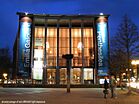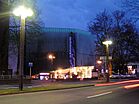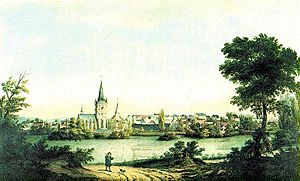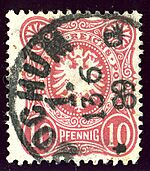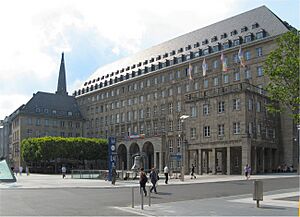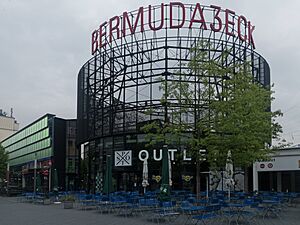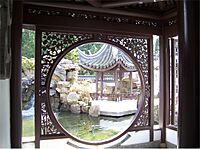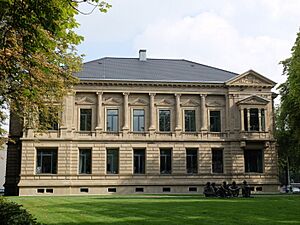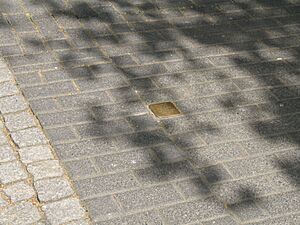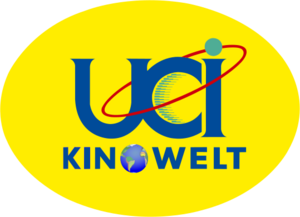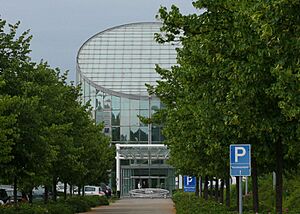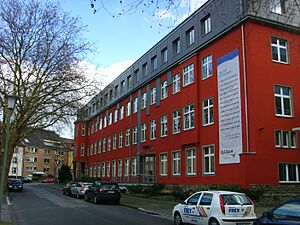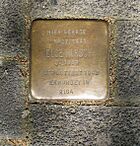Bochum facts for kids
Quick facts for kids
Bochum
Baukem (Westphalian)
|
|||
|---|---|---|---|
|
Bochum Skyline, German Mining Museum, Zeiss Planetarium Bochum, Schauspielhaus Bochum, Bochum Kammerspiele
|
|||
|
|||
| Country | Germany | ||
| State | North Rhine-Westphalia | ||
| Admin. region | Arnsberg | ||
| District | Urban district | ||
| Population
(2022-12-31)
|
|||
| • City | 365,742 | ||
| • Metro | 5,166,484 | ||
| Time zone | CET/CEST (UTC+1/+2) | ||
| Postal codes |
44701-44894
|
||
| Dialling codes | 0234, 02327 | ||
| Vehicle registration | BO, WAT | ||
| Website | www.bochum.de | ||
Bochum is a big city in North Rhine-Westphalia, a state in Germany. About 372,000 people live here, making it the sixth-largest city in its state. It's also the 16th-largest city in all of Germany.
Bochum is located in the middle of the Ruhr area, which is Germany's biggest urban region. This area is known for its history in mining and industry. The city is home to nine universities and colleges, including the Ruhr University Bochum, which is one of the ten biggest universities in Germany.
Contents
Geography
Where is Bochum located?
Bochum sits on gentle hills between the Ruhr River to the south and the Emscher River to the north. These rivers are branches of the Rhine River. The highest point in the city is about 196 meters (643 feet) above sea level, and the lowest is 43 meters (141 feet).
The city's land is mostly rolling hills, so it's not very steep. Bochum stretches about 13 kilometers (8 miles) from north to south and 17.1 kilometers (10.6 miles) from east to west. The city's edge is about 67.2 kilometers (41.8 miles) long.
Bochum is surrounded by other cities like Herne, Dortmund, Essen, and Gelsenkirchen.
What is the ground like in Bochum?
The ground in Bochum is made of sedimentary rock from the Carbon and Chalk periods. You can see these rock layers in places like the old Klosterbusch quarry and the Geological Gardens.
What are Bochum's rivers and streams like?
Bochum has two main river systems: the Ruhr in the south and the Emscher in the north. Many smaller streams flow into these rivers. The Ruhr River is used for drinking water. The Emscher River system used to be used for wastewater from industries. Now, efforts are being made to clean up the Emscher and its streams to make them healthier for nature.
What plants grow in Bochum?
The southern part of Bochum has many woods, like the Weitmarer Holz. These are usually mixed forests with oak and beech trees. You can find 844 different kinds of plants growing in the city.
What is Bochum's climate like?
Bochum has a mild climate with cool winters and short, warm summers. It doesn't often get extremely hot or cold. Temperatures can go above 30 °C (86 °F) in summer, and below freezing in winter. Sometimes, it can even snow a lot.
The city gets about 815 millimeters (32 inches) of rain each year, spread out fairly evenly. Summers can sometimes have thunderstorms. Bochum doesn't get much sunshine in winter, but it's much sunnier in late spring and early summer.
Because Bochum is quite far north, the length of daylight changes a lot. The longest day in June has over 16 hours of daylight, while the shortest day in December has less than 8 hours.
| Climate data for Essen (Bredeney), elevation: 161 m, 2016-2021 normals (source 1), all-time records (source 1+2) | |||||||||||||
|---|---|---|---|---|---|---|---|---|---|---|---|---|---|
| Month | Jan | Feb | Mar | Apr | May | Jun | Jul | Aug | Sep | Oct | Nov | Dec | Year |
| Record high °C (°F) | 16.4 (61.5) |
22.0 (71.6) |
26.4 (79.5) |
31.0 (87.8) |
31.5 (88.7) |
34.6 (94.3) |
40.0 (104.0) |
37.0 (98.6) |
34.0 (93.2) |
27.8 (82.0) |
20.0 (68.0) |
16.8 (62.2) |
40.0 (104.0) |
| Mean daily maximum °C (°F) | 5.2 (41.4) |
7.5 (45.5) |
10.3 (50.5) |
15.4 (59.7) |
19.2 (66.6) |
23.0 (73.4) |
24.3 (75.7) |
24.0 (75.2) |
20.3 (68.5) |
14.7 (58.5) |
9.5 (49.1) |
6.9 (44.4) |
15.0 (59.0) |
| Daily mean °C (°F) | 3.1 (37.6) |
4.5 (40.1) |
6.7 (44.1) |
10.8 (51.4) |
14.4 (57.9) |
18.3 (64.9) |
19.4 (66.9) |
19.3 (66.7) |
15.8 (60.4) |
11.6 (52.9) |
6.7 (44.1) |
5.0 (41.0) |
11.3 (52.3) |
| Mean daily minimum °C (°F) | 0.9 (33.6) |
1.7 (35.1) |
3.3 (37.9) |
6.1 (43.0) |
9.4 (48.9) |
13.7 (56.7) |
14.3 (57.7) |
14.6 (58.3) |
11.6 (52.9) |
8.8 (47.8) |
4.1 (39.4) |
2.9 (37.2) |
7.6 (45.7) |
| Record low °C (°F) | −17.1 (1.2) |
−15.9 (3.4) |
−11.1 (12.0) |
−4.6 (23.7) |
−0.6 (30.9) |
1.0 (33.8) |
4.4 (39.9) |
6.0 (42.8) |
3.2 (37.8) |
−2.3 (27.9) |
−6.7 (19.9) |
−16.7 (1.9) |
−17.1 (1.2) |
| Average precipitation mm (inches) | 91.0 (3.58) |
84.0 (3.31) |
71.0 (2.80) |
42.0 (1.65) |
45.0 (1.77) |
76.0 (2.99) |
50.0 (1.97) |
61.0 (2.40) |
68.0 (2.68) |
65.0 (2.56) |
70.0 (2.76) |
95.0 (3.74) |
818 (32.21) |
| Average precipitation days (≥ 1.0 mm) | 21.0 | 16.0 | 17.0 | 13.0 | 11.0 | 14.0 | 12.0 | 16.0 | 13.0 | 18.0 | 17.0 | 21.0 | 189 |
| Mean monthly sunshine hours | 42 | 86 | 132 | 195 | 234 | 217 | 221 | 185 | 177 | 91 | 67 | 42 | 1,689 |
| Source: NOAA, WetterKontor | |||||||||||||
What are Bochum's districts?
Bochum is divided into six main areas called "administrative sections" (stadtbezirke). These sections are then split into smaller sub-districts.
- Bochum-Mitte is the central part of the city. It includes areas like Innenstadt and Altenbochum. About 102,000 people live here.
- Wattenscheid is another large section. It has areas like Wattenscheid-Mitte and Höntrop. About 74,000 people live here.
- North includes Bergen and Gerthe. About 37,000 people live in this area.
- East includes Laer and Langendreer. About 55,000 people live here.
- South includes Wiemelhausen and Stiepel. About 50,000 people live in this section.
- Southwest includes Weitmar and Linden. About 56,000 people live here.
History
Bochum started around the 9th century. It was first officially mentioned in the year 1041. In 1321, Count Engelbert II gave Bochum its town charter, which meant it could govern itself more.
For a long time, Bochum was a small town. But in the 1800s, things changed a lot. The coal mining and steel industries grew very fast in the Ruhr area, and Bochum grew with them. The population jumped from about 4,500 people in 1850 to 100,000 in 1904! Many people moved to Bochum, especially from Poland, to work in the mines and factories.
Bochum during World War II
During World War II, Bochum was a target for bombings because it was a big center for making weapons and had many factories. Many people, especially women and children, left the city to find safer places.
The city was heavily bombed in 1943 and 1944. On November 4, 1944, a big steel plant was hit, causing huge fires that destroyed nearby areas. By the end of the war, much of Bochum was destroyed. Many homes were gone, and thousands of people lost their lives. Only a few buildings remained undamaged.
After the war, Bochum was part of West Germany. The city slowly rebuilt itself.
| Largest groups of foreign residents | |
| Nationality | Population (31.12.2018) |
|---|---|
| 8,852 | |
| 8,075 | |
| 3,779 | |
| 2,021 | |
| 1,902 | |
| 1,600 | |
| 1,413 | |
| 1,260 | |
| 1,209 | |
| 1,010 | |
| 987 | |
| 983 | |
| 961 | |
| 850 | |
| 850 | |
| 748 | |
| 719 | |
| 699 | |
Bochum after the war
After the war, Bochum started to become a cultural center. In 1965, the Ruhr University Bochum opened, which was the first new university in Germany after World War II.
Over time, Bochum's economy changed. It moved away from heavy industry like coal mining and steel. The last coal mines closed between 1960 and 1980. New industries, like car manufacturing, helped create jobs. However, the Opel car factory in Bochum closed in 2016.
In 1975, the city of Wattenscheid became part of Bochum. In 2007, a new synagogue for the Jewish community opened.
Places of interest
Architecture in Bochum
- Bochum City Hall was built from 1927 to 1931. It has a Renaissance style. Many of its original statues were used for the war effort, but some parts, like the "Fountain of Beauty" and "Fountain of Happiness," are still there. It also has special cast steel chimes, which were the first of their kind. A large bell from 1867, displayed at the Paris World's Fair, sits in front of the hall.
- Altes Brauhaus Rietkötter (Old Rietkötter Brewing House) is one of Bochum's oldest buildings, from 1630. It used to be a home, then a brewery, and now it's a restaurant where they still brew their own beer.
- The Kaufhaus Kortum department store was built in 1913. It's now a protected building and houses an electronics store.
- The Friedrich Lueg Haus was Bochum's first tall building, built in 1924–1925. It has seven stories and now holds offices and a cinema.
- Mutter Wittig is a baroque-style building from 1870. It was a bakery and inn and is now a restaurant.
- Sparkasse Bochum (Bochum Savings Bank) is a city landmark that opened in 1928. It was rebuilt after being damaged in the war.
- The Schlegel Tower is the only part left of the old Schlegel brewery.
- The Jahrhunderthalle (Hall of the Century) was once a gas and power station for a steel mill. Now it's a cool concert and event venue with an industrial feel.
- Dahlhauser Heide is a neighborhood built in the early 1900s by the Krupp family for their coal mine workers. The houses were designed to help workers be self-sufficient with gardens. It looks like a small, rural town.
- Blankenstein Castle was built in the 1200s. Even though it's in Hattingen, Bochum owns it. Bochum got its town charter there in 1321. Only the gate and one tower are left today.
- Haus Kemnade is a castle surrounded by water. It's also owned by Bochum, even though it's in Hattingen. It has parts built in the Renaissance and baroque styles. Today, it's a museum with old musical instruments and East Asian objects. There's also a restaurant and an old farmhouse museum nearby.
- The Exzenterhaus is Bochum's tallest building at 90.5 meters (297 feet). It's an office building built on top of an old World War II bunker. The top floors look like they are twisting.
Religious buildings
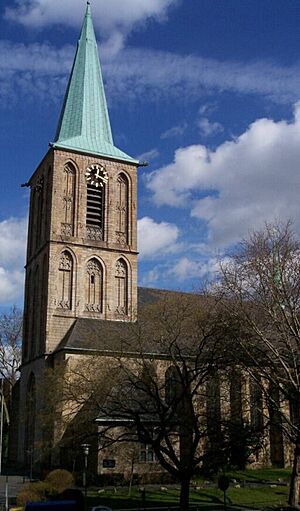
- Propsteikirche St. Peter und Paul is Bochum's oldest church, built around 785-800. It was rebuilt several times and its 68-meter (223-foot) bell tower is a city landmark. Inside, you can see a baptismal font from 1175.
- Pauluskirche is the main Protestant church. It was built in 1655 and was damaged in World War II, but later rebuilt. Next to it is a peace monument.
- The Christuskirche was built in 1879 in a neo-Gothic style. It was mostly destroyed in 1943, but its steeple was saved. Now, the steeple is a memorial for peace, and the ruins are part of a new, modern building.
- The Stiepeler Dorfkirche is over 1000 years old. It started as a small church and was later replaced by a Romanesque basilica. It has beautiful Romanesque paintings inside.
- The new synagogue opened in 2007. It has a modern design and stands next to the planetarium.
Parks and gardens
Bochum has a city zoo, a large park, and many other gardens. The Ruhr University Botanical Gardens has thousands of plants from all over the world, including a tropical garden and a unique Chinese garden.
The Geological Garden was the first of its kind in Germany. It's built on an old coal mine that operated from 1750 to 1907.
Other nice places to visit include the West Park, Lake Kemnade, Lake Ümmingen, and the Weitmarer Holz forest.
Society and culture
Fun things to do in Bochum
Bochum is a lively place for culture in the Ruhr region. It has a city theater, the Schauspielhaus Bochum, and about 20 smaller theaters. The musical Starlight Express has been playing here since 1988 and is the longest-running musical in Germany.
Bermudadreieck
The Bermudadreieck (Bermuda Triangle) is the main area for nightlife in Bochum's city center. It has about sixty different bars and restaurants with food from all over the world, like Japanese, Italian, and German.
Yearly events
- Jumble Sale – on the third Saturday of each month, in front of the city hall.
- April/May: Maiabendfest – a local festival that is hundreds of years old.
- May: Steam Festival (every other year).
- June:
- Rubissimo, Ruhr University's summer festival.
- Kemnade International.
- Extraschicht – Night of Industrial Heritage (happens in many places across the Ruhr area).
- June/July: VfL for Fun – a summer festival for Bochum's football (soccer) team, VfL Bochum 1848.
- July: Bochum Total (Music Festival) – a free rock festival that starts after school lets out.
- July or August: Bochum kulinarisch – a food festival with different cuisines.
- August: Bochumer Musiksommer – Bochum's Summer of Music.
- September: Open Flair – an international show for cabaret and street theater.
- October: Oktobermarkt – October Market.
- October/November: Bochumer Bachtage – concerts featuring music by Johann Sebastian Bach.
- October/November: Ruhrgebiets-Antiquariatstag – a sale of used and old books.
- November: Children's and Teenagers' Theatre.
- December: Weihnachtsmarkt – Christmas Market – a month-long outdoor market in downtown Bochum with performance stages.
Museums in Bochum
- The German Mining Museum teaches you about mining technology and has a real pithead tower.
- Railway Museum and Station Dahlhausen in the Dahlhausen area.
- Zeiss Planetarium.
- The former mine Zeche Hannover has a Malakow Tower and engine hall.
- Zeche Knirps ("Small Boy Mine") is a place where children can learn about how a mine works.
- Museum of local history Helf's Farm.
- Farmhouse Museum at Kemnade Castle.
- Museum of historic medical tools in the Malokos-Tower of former Mine Julius-Philipp.
- Telefonmuseum (Telephone Museum).
- Kunstmuseum Bochum (Art Museum Bochum).
Art galleries
- Museum of Art: This museum focuses on modern art from Central and Eastern Europe, German expressionism, and other unique art styles.
- Ruhr University art collection: Here, you can see both modern art and ancient Greek and Roman art, including old Greek vases.
- Schlieker House: This was the home and studio of German painter Hans-Jürgen Schlieker. It now hosts changing art shows.
- Situation Kunst: This indoor exhibition features works by famous artists like Dan Flavin and Richard Serra. It also has rooms dedicated to art from Africa and Asia.
- Musical Instrument Collection, Hans and Hede Grumbt: A large collection of musical instruments, including many clarinets.
- Ostasiatika Collection Ehrich: Kurt Ehrich's collection of East Asian objects, like Japanese netsuke.
Public art

- Richard Serra's sculpture, "Terminal," is in the town center. It's made of four tall steel plates.
- Ulrich Rückriem's sculpture, "Ohne Titel" (Untitled), is in front of the Museum of Art.
- A memorial for the herdsman at Massenberg-Boulevard reminds people of when Bochum was a farming town.
- The Engelbert statue in front of the Propsteikirche honors Count Engelbert III, who started the Maiabendfest.
- The Jobsiade-fountain at Husemann-Square shows a scene from a funny poem.
- "The involvement of the City," a sculpture by Karl-Henning Seemann, is on Schützenbahn street.
- There are many sculptures inside the municipal park.
- The big bell in front of the city hall shows how steel-casting improved in Bochum.
- Stolpersteine (stumbling stones) are small brass plaques on sidewalks. They mark the homes of people who were harmed during the Nazi era. There are 38 of these in Bochum.
Music
Bochum has its own orchestra, the Bochumer Symphoniker, which started in 1919. They perform at the Anneliese Brost Musikforum Ruhr. The Bochum Philharmonic Choir also performs several times a year with the orchestra.
The free rock festival Bochum Total happens in the city center every year since 1986. It's one of Europe's biggest music events, with many people attending.
The Kunstwerkstatt am Hellweg is an old carpenter's workshop that now hosts many concerts, from old medieval music to jazz.
Sports
- The football (soccer) club VfL Bochum has played in Germany's top division many times. They were promoted back to the first division for the 2021–2022 season.
- VfL AstroStars Bochum is a professional basketball team.
- Sparkassen Giro Bochum is a yearly road bike race.
Companies in Bochum
Many companies have their main offices or important branches in Bochum:
- ARAL AG (Head Office) – a big gas station company.
- Bochumer Eisenhütte Heintzmann GmbH & Co. KG – works with mining and steel.
- Bogestra (Head Office) – the company that runs local public transport.
- Sparkasse Bochum – a local bank.
- Vonovia – Germany's largest residential property company.
- G Data CyberDefense AG (Head Office) – a company that makes computer security software like antivirus.
- GLS Bank – a special bank that focuses on ethical and sustainable investments.
- Privatbrauerei Moritz Fiege – a regional beer brewery.
- QVC – a call center for the shopping channel.
- United Cinemas International – a movie theater company.
Transport
Roads in Bochum
Bochum is connected to Germany's main highway system by the A 40, A 43, and A 44 highways. The city also has a ring road, which is like a loop around the city center.
Trains in Bochum
Bochum has a main train station, Bochum Hauptbahnhof, which connects the city to long-distance trains and local train networks.
Buses, trams, and underground trains
Local transport is run by BOGESTRA. Bochum has an underground train line that connects the Ruhr University to Herne. There are also several tram lines that go to nearby cities like Gelsenkirchen and Witten.
Waterways
Bochum is not directly on a major waterway. The closest connection is in Herne, on the Rhine-Herne Canal. The Ruhr River forms the southern border of Bochum. It used to be used for transporting coal, but now it's mostly for cruise ships.
Airports near Bochum
The closest airports are Essen/Mülheim Airport (27 km away), Dortmund Airport (31 km away), and Düsseldorf Airport (47 km away). You can reach Düsseldorf Airport by various train lines.
Education
Universities and colleges
- Ruhr University Bochum, started in 1965.
- Bochum University of Applied Sciences (Hochschule Bochum).
- Georg Agricola University of Applied Sciences.
- Protestant University of Applied Sciences.
- Schauspielschule Bochum (Bochum drama school).
- University of Health Sciences.
Schools in Bochum
Bochum has many schools for different age groups:
- 61 primary schools.
- 9 "general schools" (Hauptschulen).
- 14 special schools.
- 11 preparatory schools (Gymnasien), which prepare students for university.
- 5 comprehensive schools (Gesamtschulen).
- 8 high schools (Realschulen).
- 2 private Waldorf schools.
Some of the preparatory schools are:
- Goethe-Schule Bochum
- Graf-Engelbert-Schule
- Heinrich-von-Kleist-Schule
- Hellweg-Schule
- Hildegardis-Schule
- Lessing-Schule
- Märkische Schule
- Neues Gymnasium Bochum
- Schiller-Schule
- Theodor-Körner-Schule
Twin towns – sister cities
Bochum has special partnerships with other cities around the world:
 Sheffield, England, United Kingdom (since 1950)
Sheffield, England, United Kingdom (since 1950) Oviedo, Spain (since 1980)
Oviedo, Spain (since 1980) Donetsk, Ukraine (since 1987)
Donetsk, Ukraine (since 1987) Nordhausen, Germany (since 1990)
Nordhausen, Germany (since 1990) Tsukuba, Japan (since 2019)
Tsukuba, Japan (since 2019)
There's a main road in Bochum called Sheffield-Ring, named after its sister city Sheffield. And in Sheffield, there's a road called Bochum Parkway!
Notable people

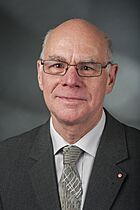
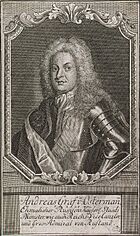

Many interesting people were born in Bochum or lived there:
- Lore Agnes (1876–1953), a politician and activist for women's rights.
- Wolfgang Clement (1940–2020), a politician who was a Minister of Economy and Labour.
- Manfred Eigen (1927–2019), who won the Nobel Prize in chemistry in 1967.
- Frank Goosen (born 1966), a comedian and writer.
- Herbert Grönemeyer (born 1956), an actor and singer, famous for his song about Bochum.
- Else Hirsch (1889–1943), a Jewish teacher who helped many children escape danger during World War II by organizing trips to other countries.
- Norbert Lammert (born 1948), a politician who was the president (Speaker) of the German parliament.
- Andrei Osterman (1686–1747), a statesman from Russia who was born in Bochum.
- Bastian Pastewka (born 1972), a well-known actor and comedian.
- Otto Schily (born 1932), a lawyer and politician.
- André Tanneberger (born 1973), also known as "ATB," a famous electronic music producer.
Sport
- Leon Goretzka (born 1995), a football (soccer) player who won an Olympic silver medal.
- Joël Matip (born 1991), a German-born Cameroonian football player.
- Mark Warnecke (born 1970), a swimmer who won a world title.
Images for kids
See also
 In Spanish: Bochum para niños
In Spanish: Bochum para niños





